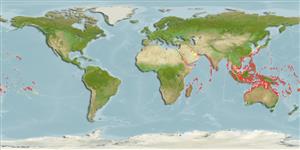>
Eupercaria/misc (Various families in series Eupercaria) >
Labridae (Wrasses)
Etymology: Labroides: Greek, labrax, -akos = a fish, Dicentrarchus labrax + Greek, suffix, oides = similar to (Ref. 45335).
More on author: Valenciennes.
Environment: milieu / climate zone / depth range / distribution range
Sinh thái học
Biển Cùng sống ở rạn san hô; không di cư; Mức độ sâu 0 - 100 m (Ref. 128797), usually 1 - 30 m (Ref. 27115). Tropical; 24°C - 28°C (Ref. 27115); 32°N - 36°S, 24°E - 124°W
Indo-Pacific: Persian Gulf (Ref.80050); Red Sea and East Africa (Ref. 4392) to the Line, Marquesas, and Ducie islands, north to southern Japan, south to Lord Howe and Rapa islands.
Bộ gần gũi / Khối lượng (Trọng lượng) / Age
Maturity: Lm ? range ? - ? cm
Max length : 14.0 cm TL con đực/không giới tính; (Ref. 55367); Tuổi cực đại được báo cáo: 4 các năm (Ref. 3426)
Các tia vây lưng cứng (tổng cộng) : 9; Các vây lưng mềm (tổng cộng) : 10 - 11; Tia cứng vây hậu môn: 3; Tia mềm vây hậu môn: 10. Often with yellow back in deep water (Ref. 48636). Scales on lateral line: 50-52 (+2 past hypural) (Ref. 1602).
Inhabits coral rich areas of inner lagoons and subtidal reef flats to seaward reefs (Ref. 1602). Feeds on crustacean ectoparasites and mucus of other fishes (Ref. 9823, 48636). Monogamous (Ref. 52884). A protogynous hermaphrodite (Ref. 55367). Stays in stations where other fish come to be cleaned. Cleaning intensity is not related to client size or commonness (Ref. 28019). Cleaning stations are occupied by a pair of adults, a group of juveniles or a group of females accompanied by a dominant male where a female becomes a functional male if the dominant male disappears (Ref. 5503). Some adults solitary and territorial. An unfamiliar visitor is usually greeted by dance-like movements with the tail maneuvering the back part of the body up and down. Juveniles behave this way when divers approach closely (Ref. 48636). Minimum depth range of 1 meter in Ref. 27115.
Life cycle and mating behavior
Chín muồi sinh dục | Sự tái sinh sản | Đẻ trứng | Các trứng | Sự sinh sản | Ấu trùng
Bi-directional sex change has been confirmed for this species (Ref. 103751). Oviparous, distinct pairing during breeding (Ref. 205). Pelagic spawners. Sex reversal is completed in 14-18 days (Ref. 34185, 34258). A monandric species (Ref. 55367). Length at sex change = 8.8 cm TL (Ref. 55367). Monogamous mating is observed as both facultative and social (Ref. 52884).
Randall, J.E., G.R. Allen and R.C. Steene, 1990. Fishes of the Great Barrier Reef and Coral Sea. University of Hawaii Press, Honolulu, Hawaii. 506 p. (Ref. 2334)
IUCN Red List Status (Ref. 130435: Version 2024-1)
Threat to humans
Harmless
Human uses
Các nghề cá: không ích lợi (thú vị); Bể nuôi cá: Tính thương mại
Các công cụ
Special reports
Download XML
Các nguồn internet
Estimates based on models
Preferred temperature (Ref.
123201): 24.6 - 29, mean 27.8 °C (based on 1388 cells).
Phylogenetic diversity index (Ref.
82804): PD
50 = 0.5312 [Uniqueness, from 0.5 = low to 2.0 = high].
Bayesian length-weight: a=0.00589 (0.00335 - 0.01035), b=3.17 (3.01 - 3.33), in cm total length, based on LWR estimates for this species & (Sub)family-body (Ref.
93245).
Mức dinh dưỡng (Ref.
69278): 3.5 ±0.4 se; based on diet studies.
Thích nghi nhanh (Ref.
120179): Trung bình, thời gian nhân đôi của chủng quần tối thiểu là 1.4 - 4.4 năm (tmax=4).
Fishing Vulnerability (Ref.
59153): Low vulnerability (10 of 100).
Nutrients (Ref.
124155): Calcium = 103 [54, 177] mg/100g; Iron = 0.69 [0.39, 1.37] mg/100g; Protein = 18 [15, 20] %; Omega3 = 0.104 [0.059, 0.182] g/100g; Selenium = 27.8 [13.9, 56.3] μg/100g; VitaminA = 140 [40, 597] μg/100g; Zinc = 1.76 [1.15, 2.82] mg/100g (wet weight);
